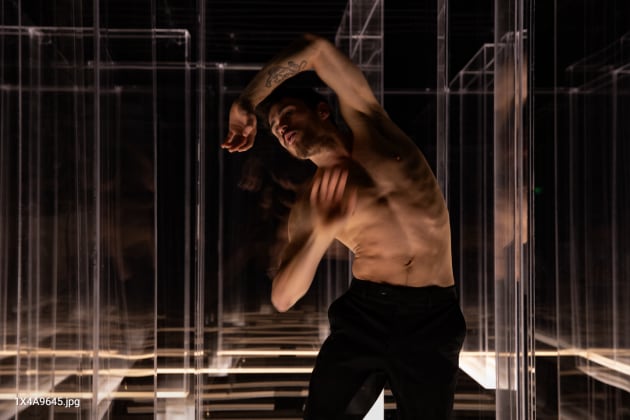REVIEW: Brisbane Festival 'Salamander'

L Shed Dock B, Northshore, Brisbane
September 2
Salamander has been promoted as the centrepiece of this year’s Brisbane Festival and its promotion is well-deserved. A promenade dance-theatre work of quite epic proportions, Salamander is staged in a large riverside warehouse that has been transformed through light, design, sound, and movement into an apocalyptic dream-like world of steaming heat, inhabited by creatures in a desperate race against time.
British director and choreographer Maxine Doyle, known for her work on immersive productions for the UK company Punchdrunk, most recently The Burnt City, collaborated with stage designer and artist Es Devlin in the conception of Salamander. Devlin is noted for her large-scale sculptural artworks and installations – including stage design. They drew inspiration from J.G.Ballard’s novel The Drowned World, and satirical film, Don’t look Up, creating a work that has a kind of dystopian beauty about it.
Beautifully lit by Ben Hughes with costumes designed by Bruce McKinven, Salamander is brought to life by the Australian composer and singer Rachael Dease, with the six dancers of the Australasian Dance Collective (Gabrielle Nankivell, Lilly King, Harrison Elliott Jack Lister, Jag Popham and Chase Clegg-Robinson) and guests May Greenberg and Paul Zivkovich.
The work is divided roughly into two parts, each situated in a different part of the darkened space. In the first, a large maze of clear Perspex screens (design Devlin), lit from below, is surrounded by a shallow, square moat of inky black water. The screens both frame and contain the dancers, while the audience surrounds the prison-like installation on three sides, standing either above it or at ground level.
To a rumbling soundscape a lone male dancer rises from within the installation. Others join him, all naked from waist up, torsos pulsing to a heartbeat rhythm and creating a visually striking image against the blackness of the surrounds. They seem like creatures trapped, the surrounding water a malevolent force. Hazmat suits are donned by some to traverse the moat. A dancer in a 50s styled one-piece bathing suit and floral bathing cap slinks through the water, salamander-like.
Finally, symbolising perhaps the devil-may-care attitude we have towards impending doom, the dancers, change into red outfits, and "party" hard, ending the first section.
The audience is then moved to seats around a large circular space, dominated by a 12-foot long orange table. Anchored in its centre, the table’s outer legs are on casters allowing it to spin when pushed by the dancers. Either spinning or still, it is a metaphor for the passing of time.
The dancers, all in red, leap, slide and tumble over, under and across the table, or stand on it as it spins. They in turn dominate or are subjugated by its relentless spinning. One section evokes the last supper of the Leonardo di Caprio character in Don’t Look Up, who chooses to spend his last hours with family and friends.
Dease, in a glittering green gown, acts almost as a Greek chorus in this second section, commenting in haunting amplified song as she moves majestically through the space. Throughout however, the music is pivotal to the mood, from a haunting Gaelic tone to relentless pounding, and, rather left of field, a selection from Verdi’s Requiem Dies Irae.
Water again features heavily in this section as a circle of rain envelopes the spinning table. Water here seems to be a symbol of renewal and hope, which is the mood as the work ends.
Running at just over 80 minutes, Salamander was captivating – a visual feast – although perhaps some later moments of repetition could be judiciously pruned. Nevertheless, it is an extraordinary tour de force – by the dancers especially, who get little respite. Every dancer is remarkable.
Salamander is running until September 23. Wheelchair accessible, it’s a must see!
– DENISE RICHARDSON


